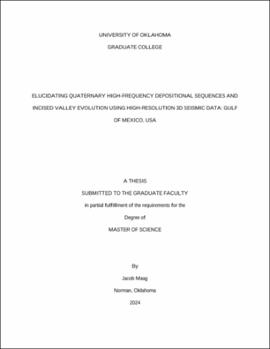| dc.contributor.advisor | Bedle, Heather | |
| dc.contributor.author | Maag, Jacob | |
| dc.date.accessioned | 2024-04-26T16:22:20Z | |
| dc.date.available | 2024-04-26T16:22:20Z | |
| dc.date.issued | 2024 | |
| dc.identifier.uri | https://hdl.handle.net/11244/340244 | |
| dc.description.abstract | Resolution limitations of conventional seismic methods prohibit the subsurface investigation of high-frequency—fourth and fifth-order—depositional sequences and their associated fluvial features. However, modern high-frequency 3D seismic methods provide sufficient resolution for such analyses. This study utilized high-resolution 3D seismic data to investigate Quaternary high-frequency depositional sequences and incised valley evolution on the northwestern Gulf of Mexico’s inner shelf. Within the shallowest 200 milliseconds of the subsurface, three major unconformities were identified and mapped. Through a seismic attribute analysis and the employment of machine learning algorithms, fluvial features along each unconformity—likely related to the Brazos and/ or Trinity Rivers—were delineated and determined to be incised valleys which are known to have formed during eustatic lowstand events. Using a tripartite seismic stratigraphic scheme, systems tracts—lowstand systems tracts, transgressive systems tracts, and highstand systems tracts—were identified within each defined sequence, and sequence boundaries (i.e., unconformities) were correlated to lowstand events on a eustatic sea level curve. Incised valley evolution was then investigated which revealed that such systems maintain a tendency to become increasingly sinuous and dendritic in response to rapid transgression. Finally, various seismic attributes were employed in a principal component analysis which facilitated an understanding of lithologic distribution throughout the seismic volume. This study underscores the significance of high-resolution seismic data, seismic attributes, and machine learning in understanding high-frequency sea level cycles and provides insight into Late Quaternary depositional processes on the Gulf of Mexico’s inner shelf. Knowledge of these high-frequency depositional sequences in the shallow subsurface may aid in understanding the small-scale heterogeneity of deeper reservoirs where such features are unresolvable through conventional seismic methods. | en_US |
| dc.language | en_US | en_US |
| dc.subject | Sequence Stratigraphy | en_US |
| dc.subject | High-resolution Seismic Data | en_US |
| dc.subject | Incised Valleys | en_US |
| dc.subject | Quaternary | en_US |
| dc.subject | Gulf of Mexico | en_US |
| dc.title | Elucidating Quaternary High-frequency Depositional Sequences and Incised Valley Evolution Using High-resolution 3D Seismic Data: Gulf of Mexico, USA | en_US |
| dc.contributor.committeeMember | Pranter, Matthew | |
| dc.contributor.committeeMember | George, Sarah | |
| dc.date.manuscript | 2024 | |
| dc.thesis.degree | Master of Science | en_US |
| ou.group | Mewbourne College of Earth and Energy::School of Geosciences | en_US |
| shareok.nativefileaccess | restricted | en_US |
